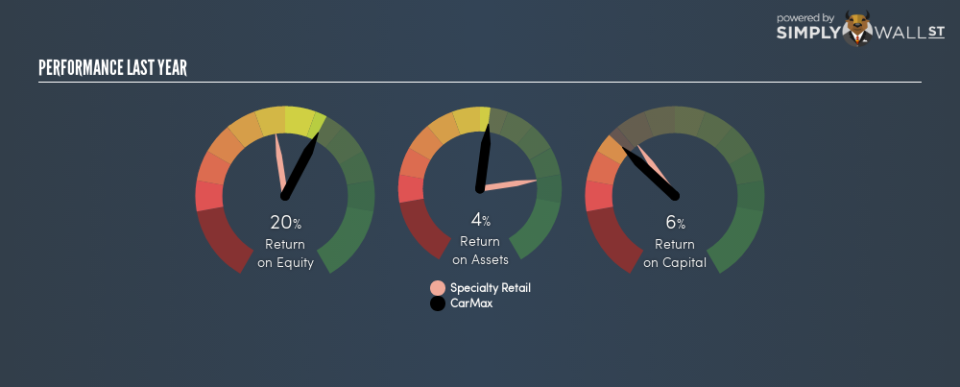CarMax Inc (NYSE:KMX) Delivered A Better ROE Than The Industry, Here’s Why

This article is intended for those of you who are at the beginning of your investing journey and want to start learning about core concepts of fundamental analysis on practical examples from today’s market.
CarMax Inc (NYSE:KMX) delivered an ROE of 20.4% over the past 12 months, which is an impressive feat relative to its industry average of 14.6% during the same period. While the impressive ratio tells us that KMX has made significant profits from little equity capital, ROE doesn’t tell us if KMX has borrowed debt to make this happen. In this article, we’ll closely examine some factors like financial leverage to evaluate the sustainability of KMX’s ROE.
See our latest analysis for CarMax
Peeling the layers of ROE – trisecting a company’s profitability
Return on Equity (ROE) is a measure of CarMax’s profit relative to its shareholders’ equity. For example, if the company invests $1 in the form of equity, it will generate $0.20 in earnings from this. Generally speaking, a higher ROE is preferred; however, there are other factors we must also consider before making any conclusions.
Return on Equity = Net Profit ÷ Shareholders Equity
ROE is measured against cost of equity in order to determine the efficiency of CarMax’s equity capital deployed. Its cost of equity is 14.8%. This means CarMax returns enough to cover its own cost of equity, with a buffer of 5.6%. This sustainable practice implies that the company pays less for its capital than what it generates in return. ROE can be split up into three useful ratios: net profit margin, asset turnover, and financial leverage. This is called the Dupont Formula:
Dupont Formula
ROE = profit margin × asset turnover × financial leverage
ROE = (annual net profit ÷ sales) × (sales ÷ assets) × (assets ÷ shareholders’ equity)
ROE = annual net profit ÷ shareholders’ equity
The first component is profit margin, which measures how much of sales is retained after the company pays for all its expenses. Asset turnover shows how much revenue CarMax can generate with its current asset base. The most interesting ratio, and reflective of sustainability of its ROE, is financial leverage. Since financial leverage can artificially inflate ROE, we need to look at how much debt CarMax currently has. Currently the debt-to-equity ratio stands at more than 2.5 times, which means its above-average ROE is driven by significant debt levels.
Next Steps:
ROE is one of many ratios which meaningfully dissects financial statements, which illustrates the quality of a company. CarMax exhibits a strong ROE against its peers, as well as sufficient returns to cover its cost of equity. Its high debt level means its strong ROE may be driven by debt funding which raises concerns over the sustainability of CarMax’s returns. Although ROE can be a useful metric, it is only a small part of diligent research.
For CarMax, I’ve compiled three key factors you should look at:
Financial Health: Does it have a healthy balance sheet? Take a look at our free balance sheet analysis with six simple checks on key factors like leverage and risk.
Valuation: What is CarMax worth today? Is the stock undervalued, even when its growth outlook is factored into its intrinsic value? The intrinsic value infographic in our free research report helps visualize whether CarMax is currently mispriced by the market.
Other High-Growth Alternatives : Are there other high-growth stocks you could be holding instead of CarMax? Explore our interactive list of stocks with large growth potential to get an idea of what else is out there you may be missing!
To help readers see past the short term volatility of the financial market, we aim to bring you a long-term focused research analysis purely driven by fundamental data. Note that our analysis does not factor in the latest price-sensitive company announcements.
The author is an independent contributor and at the time of publication had no position in the stocks mentioned. For errors that warrant correction please contact the editor at editorial-team@simplywallst.com.


